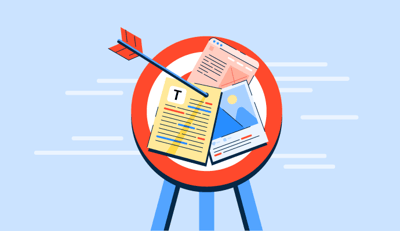August 25, 2025
 by Soundarya Jayaraman / August 25, 2025
by Soundarya Jayaraman / August 25, 2025

As marketers, we know how critical it is to shape a brand experience that feels consistent and memorable. One of the most powerful ways to do this is through brand language: the words, tone, and style that make every campaign, landing page, and social post unmistakably ours.
Brand language is not just about taglines or clever product copy. It is the foundation of how we communicate our brand’s purpose, values, and personality in a way that resonates with our audience. When done well, it turns messaging into a strategic asset that drives recognition, trust, and loyalty.
Brand language refers to the words a brand uses to define its purpose, brand tone, and products. It encompasses specific words, phrases, and even the tone of voice used to communicate a brand's identity and message.
However, crafting a strong brand voice goes beyond using brand intelligence tools and analysis. It requires a deep understanding of your brand's values and personality.
There are many techniques and strategies to build brand language, some more obvious than others.
In this guide, we’ll start with the fundamentals, designed for marketers, entrepreneurs, and content creators who want to stand out, connect with their audience on a deeper level, and turn consistent messaging into lasting brand loyalty.
Brand language is more than a creative flourish; it’s the foundation for how customers perceive, remember, and connect with your brand. Every word you choose, every tone you strike, and every visual you pair with it sends a signal about who you are and what you stand for.
When your tone, vocabulary, style, and visuals work together, they create a consistent brand experience across every touchpoint, whether someone encounters you in an ad, on social media, or in a customer service email. That consistency builds familiarity, and familiarity breeds trust.
Take Duolingo, for example. Its cheeky, playful tone doesn’t just show up in app notifications. It’s baked into social media posts, help articles, and even the way its mascot “talks.” This consistency makes the brand instantly recognizable and reinforces its promise of making language learning fun and engaging.
The result? Customers don’t just recognize your brand. They remember it, prefer it, and stay loyal to it.
A strong brand language is made up of more than just what you say. It’s also how you say it and how it looks when it reaches your audience. These four elements work together to create a consistent, recognizable identity.
The attitude or emotion conveyed through your words. Your tone might be friendly and approachable, authoritative and expert, or playful and humorous, depending on your brand’s personality and the context. It sets the emotional connection with your audience and helps them “feel” your brand.
Example: Mailchimp uses a warm, witty tone that makes even technical marketing topics feel approachable, building trust without sounding corporate.
The specific words, phrases, and expressions your brand consistently uses. This choice of language reflects your values, industry expertise, and personality—whether it’s formal and technical, casual and conversational, or somewhere in between. Consistent vocabulary reinforces your brand identity over time.
Example: Nike leans on action-oriented words like “just do it,” “push,” and “move” to reinforce its motivational, athletic identity.
The overall presentation and structure of your communication. This includes grammar preferences, sentence length, capitalization, punctuation, and formatting. A well-defined style ensures your brand looks and sounds consistent across all platforms, from social posts to product manuals.
Example: Apple uses clean, minimalist copy with short sentences and plenty of white space, reflecting the sleek design of its products.
The visual counterpart to your written and spoken words. This includes color palette, typography, imagery, illustration style, and iconography, all of which work together to communicate your brand’s personality at a glance and make your content instantly recognizable.
Example: Coca-Cola’s signature red, flowing script typography, and nostalgic imagery create instant brand recognition worldwide.
When these four aspects are clearly defined and consistently applied, your brand language becomes a powerful tool for building recognition, trust, and loyalty.
Developing your brand is about understanding your core identity and expressing it in a way that connects with your target audience.
Every brand needs to ask itself this question to help define its brand voice. After all, without your audience, you don’t have a brand identity. For the sake of finding your audience, there are a few strategies that have stood the test of time and remained fan favorites.
Let’s discuss three of the most widely used:
Otherwise known as buyer personas, creating user personas has been a go-to method for many brands when it comes to understanding who is using their products or services. This process typically goes a little beyond the average chatbot.
Creating these personas involves asking users a series of questions via surveys and interviews and finding patterns in their answers. Once you have completed enough interviews and surveys, you can begin to create personas to understand your audience better.
It’s not overly complicated, nor does it require any special skills. However, depending on the number of people in your audience, it can take quite a while. It helps tremendously to have a few analytics tools handy during this period.
Possibly one of the most effective and straightforward ways brands understand their audiences is just by talking to them. That’s all there is to it. These conversations can manifest in a variety of different ways, but quick emails, phone calls, or face-to-face interactions have always been the most effective ways to get to know your audience.
Listening to your customers also encourages customer advocacy. Your customers, better than anyone, know how you can improve your brand. If anything, this is a great practice to help improve your customer relations. Everyone likes a brand that’s involved.
The whole point of understanding your audience is to understand their behaviors. Understanding what makes them tick when they’re buying from your brand means that you can focus your efforts on marketing your brand identity based on those behaviors.
It's not overly complicated, but this sort of research can help any brand define its voice.
80% of 18 to 34-year-olds have written reviews, proving that customers are talking about you -- whether you're listening or not.
Read reviews to understand what customers want from your brand. You'll see where you are providing the most value and understand how your product or service is being used.
In addition, reviews provide content from the mouths of your customers you can repurpose and use in your marketing materials, ensuring it is, without a doubt, a voice with relevance.
If you're a B2B software or service provider, create your free G2 profile and start connecting with customers now. Analyzing G2 reviews can help you identify recurring themes, pick up on your customers’ vocabulary, and ensure your messaging reflects the way real users talk about your brand.
It’s fairly obvious that in order to understand your brand language, you have to understand what your brand stands for. Each brand on the market today has (or should have) a specific image it wants to portray.
So, now that you’ve established who your audience is, there are important questions you have to ask yourself to define brand voice further:
Yes, even brands have cultures. Brand language and culture are similar, as they both help define a brand. But culture takes a more direct approach.
Think of it this way: Brand culture is a brand's DNA, and brand language is how the brand organizes itself. Brand language represents the vibes that the brand puts out into the world—it’s the brand tone.
You can see that these two have a lot to do with each other. Defining your brand language means first defining your brand culture. How do we do that?
First, you have to define your brand values, people, and purpose. Find out what your brand stands for. Then, it’s just a matter of displaying that for everyone to see. Make these values clear, and your culture will be clear too.
This question ties in with the one above, but it’s extremely important to the brand language by itself, so it gets a spot of its own.
Every brand, regardless of industry, has to have a mission. Whether it’s to provide quality shoes or educate people on the importance of green energy, you have to have one. Highlighting this mission plays a key role in defining your brand language.
Now that we’ve discussed the two most important questions any brand can ever ask itself, let’s discuss what we should do with this newly found information.
Define exactly how your brand should sound and look in writing so your messaging stays consistent across every channel, whether it’s a social post, email, blog article, or customer service reply.
Document your tone of voice (friendly, authoritative, playful), your vocabulary choices (preferred words, phrases, and any terms to avoid), and your style rules for grammar, punctuation, capitalization, and formatting. Decide on sentence length, headline case (title case vs. sentence case), Oxford comma usage, and when to bold, italicize, or use bullet points.
The goal is to make your brand instantly recognizable through both what you say and how it appears on the page.
A useful way to shape your brand’s tone is the three-word technique. Select three core words that capture your personality For each word, write a short description and define clear “Do” and “Don’t” guidelines.
For example, let’s use the following words:
Next, we’re going to throw them into a columned chart and work out some more details:
| Characteristics | Description | Do | Don't |
| Trustworthy | We’ve gained the trust of every client we’ve served with our quality and professionalism. | Give clients a reason to trust us. Show them what we’re made of and that we’re worth trusting. |
Abandon that trust. Give them any reason not to trust us. |
| Persistent | We’re very persistent in achieving our goals. We don’t let any obstacle stop us. | Use our persistence always to give the client what they’re after. Use our persistence to help us climb over any obstacle we face. |
Annoy our clients with our persistence. Let our persistence not blind us to bad decisions. |
| Passionate | We work hard at our jobs because we love what we do. | Express that passion in our work. Strive to better ourselves constantly. |
Let that passion wash out. Be passive with your tone of voice. |
Now that you have your words, you can begin to structure your brand language guidelines based on what you believe best describes your brand.
With a chart like this, you’ve basically given yourself a roadmap, just in case anyone gets lost along the way.
Once agreed upon, these words should be built into your brand style guide, along with tone, vocabulary, and style rules, and shared across teams so every piece of communication stays consistent.
You know your culture and your audience. It’s time to channel that into a meaningful and visual brand language.
Visual brand language is the silent counterpart of brand language. It uses visual elements to communicate a company's identity and message. It's a set of design choices that work together to create a recognizable and consistent look and feel for a brand.
The easiest way to approach this is to consider how people would perceive your language if it weren’t paired with your brand’s logo or name. How do you think they’d receive it? The goal is to create a language that customers recognize as yours.
Here are some aspects of visual brand language:
Brand language isn’t a one-time project. It’s a living part of your brand identity. Once your tone, vocabulary, style, and visuals are in place, test them in the real world to see how they resonate.
The goal is to maintain a voice that feels authentic, resonates with your audience, and supports your business goals—even as both your brand and your market evolve.
Even with the best intentions, it’s easy for brand language to miss the mark. Avoid these common pitfalls to keep your voice clear, consistent, and impactful.
Industry terms can be useful, but overloading your content with jargon can alienate readers. Aim for clarity and accessibility. Your audience should never need a dictionary to understand your message.
It’s tempting to mirror successful brands in your space, but imitation dilutes your identity. Take inspiration from others, but ensure your tone, vocabulary, and messaging are distinctly yours.
Witty or edgy copy can grab attention, but if the message gets lost, it’s not doing its job. Make sure your audience understands the point before adding flair.
Your brand voice and visual identity should reinforce each other. A playful tone paired with overly corporate visuals (or vice versa) creates a disconnect and weakens your overall brand experience.
If your brand language only lives in people’s heads, it will inevitably drift over time. A documented style guide ensures everyone—internal teams and external partners—uses the same voice and standards.
What feels witty or friendly in one market might fall flat, or even offend, in another. Global or multi-regional brands must adapt tone and word choice without losing their core identity.
Once your brand language is defined, the real challenge is keeping it consistent in day-to-day content creation. These habits will help you apply your voice effectively across all channels.
Bottom line: The best brand language isn’t just written in a guide; it’s actively practiced, reviewed, and refined in every piece of content you publish.
TIP: If you think you might need some professional help building the perfect brand language, check out the best branding agencies on the market!
There are quite a few good examples of brand language success. Most of the time, it just takes a single phrase or even a simple word to make us think of a brand instantly.
Here are a few brands that are doing it right:
We saw about Duolingo already. Duolingo has turned learning into a viral, personality-driven experience, largely thanks to its unapologetically cheeky brand language as mentioned earlier. From push notifications that playfully guilt-trip users (“Hey, you’ve been ignoring me…”) to social media posts that lean into internet humor and memes, Duolingo’s tone is instantly recognizable.

Its brand voice is confident, witty, and at times, a little mischievous, matching the brand’s goal of making language learning feel fun and addictive. The Duolingo owl mascot is a key part of this language, not just visually but as a “character” that embodies the brand’s personality.
Behind the scenes, Duolingo maintains a detailed brand language guide that outlines its tone, humor style, vocabulary, and visual rules, ensuring consistency across the app, marketing, and global campaigns. This disciplined approach is why Duolingo’s quirky voice feels seamless no matter where you encounter it.
It has made Duolingo not just an educational tool, but a pop culture phenomenon.
Innocent Drinks has built a cult following not just for its smoothies and juices, but for its unmistakably playful and personable brand language. From packaging that chats to you to social media posts that blend puns, wit, and genuine friendliness, every interaction feels like it’s coming from a charming friend.

This tone is no accident. Its internal tone of voice ensures that whether you’re reading the side of a juice carton or a tweet, the voice feels consistent and recognizably Innocent. The brand’s commitment to lighthearted yet sincere communication has helped it stand out in a competitive FMCG market.
BMW's visual brand language is one of the most recognizable in the automotive world. Regardless of social status, professional training, or whether one is a fan of the brand or not, people recognize BMW cars not only by the logos but by specific design elements that made history.
A small glimpse of one of the brand's cars is often all it takes for someone to recognize one of its creations, and it has much to do with its visual brand language.
 Source: BMW
Source: BMW
If you take a look at any BMW, modern or not, you’ll notice many design cues that it has implemented over the years. A good example would be the front grills on the cars—they are part of the brand identity, elements easily recognizable by everybody.
Another really good example of BMW’s brand visual language is its famous M stripes. These colors, regardless of whether or not they're on a BMW, are almost instantly seen as the BMW M series.
The point is, BMW is very aware of what makes a BMW a BMW. It has developed its brand strategy over the years and knows how to execute it perfectly. It will always be a matter of quality, reliability, a lot of viability, and trust among BMW car owners. Its marketing strategy, however, goes way beyond these technical details and helped build a brand that is almost iconic.
Groove is a great example of how brand language changes over time. As its user base increased, so did the need for a change in brand strategy.
The brand's mission was to make its user experience as clean as possible but still maintain that “groovy” feeling.
Groove did this brand identity revamp in the right way: by taking user feedback. Every feature, every design, and every single aspect of the new identity was based on what the users wanted. Needless to say, it has worked out quite well for the brand, as its feedback now is incredible.
 Source: Groove
Source: Groove
What did Groove change? To put it simply, everything. To start, it redesigned its most important visual asset: the company logo. The old rainbow was ditched and replaced with a simple smiley “G” logo.
Other than that, it basically rebuilt every branded asset from the ground up. It put together a style guide applicable across all its apps and websites, applying a new, modern, and clean look to the brand, which led to a new and improved user experience. The groovy feeling, however, was successfully maintained, as the new designs featured playful elements, elegant new fonts, and fresh colors.
All the elements were designed and placed according to a branded approach to efficiency and user experience. Its offer has always included easy-to-use products, but now, through rebranding and redesign, it has also managed to transmit this information visually.
Whirlpool owns roughly 28 sub-brands worldwide. Each one promotes products with strikingly similar designs, but it wasn’t always that way.
As we know it now, Whirlpool is probably the biggest supplier of household appliances. It and its sub-brands, like KitchenAid, make just about any appliance you could think of – and probably some that you can’t.
 Source: Whirlpool
Source: Whirlpool
Back in the 1990s, Whirlpool conducted research that proved the lack of brand loyalty. In fact, two-thirds of the customers who entered a store looking for a new appliance had no idea what brand they were looking for.
Fast-forward a little bit, and Whirlpool decided to bring designer Chuck Jones on board as chief designer. Together, with the help of design teams all over the world, they created Whirlpool’s brand visual language that we recognize today. They also created a simple brand language style guide to keep the brand on track.
Using a unique design template, Whirlpool unified its brand tone, and its product sales have never been higher.
How much can you save with Geico? How long does it take? Exactly. In your head, you just answered those questions flawlessly.
Geico has done an amazing job at maintaining its culture and language for years. Whether it’s the brand's catchphrase or the British gecko, it’s instantly recognizable.
 Source: Geico
Source: Geico
Its brand strategy is simple: familiarize people with the brand by using a funny gecko. It’s a character that we’ve all grown to know and love – even if it is the mascot for an insurance commercial.
Geico took something so simple and mediocre and turned it into a super famous brand, all by including a tiny gecko in the brand language style guide.
This is a great approach toward marketing and advertising, as the most simple designs and elements are the easiest to remember, adopt, and associate with a company. A complicated design, on the other hand, would have been less effective.
Another great example of a brand that has mastered brand language is Disney.
Disney has quickly won its way into the hearts and minds of just about everyone because of the image that it has put out.
Disney is known for its customer service in its amusement parks and the heartfelt stories it tells in its movies.
 Source: Disney
Source: Disney
You see, it’s all calculated based on its brand language. Everyone sees Disney as the happiest place on Earth because the brand has developed its brand language perfectly.
It has always been associated with a positive attitude, happiness, and success. All its elements, beloved characters, and stories contribute to this positive image, and we all know how important such an image association is in customers’ minds. Disney knew it as well. Hence, its world-renowned success.
Got more questions. Here are the answers.
Brand voice is the consistent personality and tone you use in communication, while brand language is broader — it includes your voice plus the vocabulary, style, and visual elements that express your brand identity.
Yes. Even a lightweight set of tone and style guidelines can make a small business feel more professional, trustworthy, and memorable, especially when competing with bigger brands.
Absolutely. Many teams build their own by researching their audience, studying competitors, and documenting clear guidelines. Tools like Notion, Google Docs, and Canva help organize and share them.
Keep your style guide easy to access, train new hires on it, and bake it into content approval workflows. Periodic team reviews help reinforce best practices.
If it no longer resonates with your audience or reflects your business, update it. This might be a light tone refresh or a full rebrand, depending on the gap.
Yes. Consistent, relatable messaging builds familiarity and trust, which are key to retention. A strong brand language makes your brand feel like a dependable personality that customers return to.
Brand voice is your brand’s consistent personality, while tone changes based on context. For example, your overall voice might be friendly and approachable, but the tone shifts between a lighthearted social media post and a serious customer support email.
Start by defining your brand’s values and audience. Then document tone, vocabulary, and style preferences in a style guide. Include examples of “do” and “don’t” phrasing, so teams know how to apply your brand language consistently across channels.
Visuals reinforce your written language and make your brand instantly recognizable. A strong visual brand language, through colors, typography, and imagery, creates consistency across all touchpoints and strengthens emotional connection with your audience.
The most important detail to take away from this is to make your brand’s voice heard. Make it unique and make it stand for something.
Next time you send a newsletter, update content, run an ad, produce a product, or provide a service, think about the message you’re sending. If that message doesn’t scream your brand’s language, it’s time to start developing a new tone of voice.
Stay on top of the latest branding statistics to gain a competitive edge in your domain.
This article was originally published in 2019. It has been updated with new information.
Soundarya Jayaraman is a Content Marketing Specialist at G2, focusing on cybersecurity. Formerly a reporter, Soundarya now covers the evolving cybersecurity landscape, how it affects businesses and individuals, and how technology can help. You can find her extensive writings on cloud security and zero-day attacks. When not writing, you can find her painting or reading.
Brand ambassadors are real people who love your brand, who want to see your brand succeed, and...
 by Jessica Huhn
by Jessica Huhn
Having a way with words can be your full-time job - I promise.
 by Daniella Alscher
by Daniella Alscher
Communication is the most basic thing we learn as human beings.
 by Nanditha Vijayaraghavan
by Nanditha Vijayaraghavan
Brand ambassadors are real people who love your brand, who want to see your brand succeed, and...
 by Jessica Huhn
by Jessica Huhn
Having a way with words can be your full-time job - I promise.
 by Daniella Alscher
by Daniella Alscher


